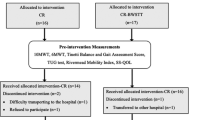Summary
This study was done to determine the independent predictors of long-term survival and long-term functional outcome in geriatric stroke patients with a high level of co-morbidity. We prospectively recruited 302 consecutive patients transferred from local hospitals of acute care to inpatient geriatric rehabilitation with a median of 23 days after stroke. The cohort with a mean age of 75.1 (range 60–90) years was followed up for 2 years after discharge from rehabilitation. The 24 month survival rate was 71.2%. Urinary continence (p=0,000), younger age (p=0.000), and absence of coronary artery disease (CAD) (p=0.039) were predictors of survival. Independence in activities of daily living (Barthel Index (BI)≥85) 24 months after discharge was 43.2% and predicted by an admission BI≥50 (p=0.000), urinary continence (p=0.007), and absence of CAD (p=0.018). Good functional outcome by the Modified Rankin Scale (MRS≤3) 24 months after discharge was 38.4%. It was predicted by absence of CAD (p=0.001), first-ever stroke (p=0.014), admission BI≥50 (p=0.024), urinary continence (p=0.025), mild motor paresis (p=0.032), and good sitting balance (p=0.039). Our study of a relatively aged and co-morbid stroke cohort confirmed most of the well-known predictors of outcome. A new result is that CAD also seems to be an important determinant of long-term outcome.
Zusammenfassung
Ziel der vorliegenden Studie war, die unabhängigen Prädiktoren des Langzeitoutcomes nach Schlaganfall zu ermitteln. Es wurden prospektiv 302 konsekutiv aus mehreren Akutkliniken in eine geriatrische Rehabilitationsabteilung verlegte Patienten eingeschlossen. Der Schlaganfall lag zum Verlegungszeitpunkt im Median 23 Tage zurück und das Alter betrug im Mittel 75,1 (Range 60–90) Jahre. Die Abschlussuntersuchung erfolgte 24 Monate nach Entlassung aus der stationären geriatrischen Rehabilitation. Die Überlebensrate nach 24 Monaten betrug 71,2%. Urinkontinenz (p=0,000), niedrigeres Alter (p=0,000) und fehlende koronare Herzkrankheit (KHK) (p=0,039) erwiesen sich als Prädiktoren des Langzeitüberlebens. Unabhängig in den Aktivitäten des täglichen Lebens (Barthel Index (BI)≥85) waren 24 Monate nach Entlassung 43,2%. Als Prädiktoren dafür wurden ermittelt ein Aufnahme-BI≥50 (p=0,000), eine Urinkontinenz (p=0,007) und eine fehlende KHK (p=0,018). Ein gutes funktionelles Outcome anhand der modifizierten Rankin Scale (MRS≤3) erzielten 24 Monate nach Entlassung 38,4%. Als Prädiktoren dafür erwiesen sich fehlende KHK (p=0,001), erster Schlaganfall (p=0,014), Aufnahme-BI≥50 (p=0,024), Urinkontinenz (p=0,025), leichte Hemiparese (p=0,032) und gute Sitzbalance (p=0,039). Unsere Untersuchung einer relativ alten und erheblich multimorbiden Schlaganfallkohorte bestätigt die meisten der gut belegten prognostischen Merkmale. Ein neues Ergebnis ist, dass auch die KHK ein wichtiger Prädiktor des Langzeitoutcomes sein dürfte.
Similar content being viewed by others
Author information
Authors and Affiliations
Additional information
Received: 1 December 2000 Accepted: 26 January 2001
Rights and permissions
About this article
Cite this article
Meins, W., Meier-Baumgartner, HP., Neetz, D. et al. Predictors of favorable outcome in elderly stroke patients two years after discharge from geriatric rehabilitation. Z Gerontol Geriat 34, 395–400 (2001). https://doi.org/10.1007/s003910170041
Issue Date:
DOI: https://doi.org/10.1007/s003910170041




